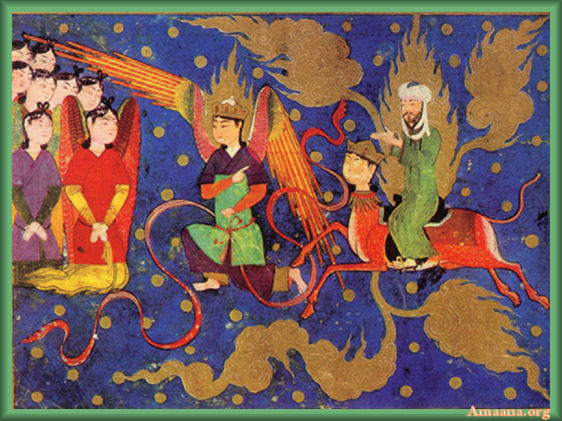
Miraj – Spiritual or Corporeal
By Mumtaz Ali Tajddin S. Ali
Editor’s Note: Miraj is observed on 27 Rajab. Please follow link for Calendar Converter in the horizontal menu above under Muslim Holidays.
The word miraj is derived from uruj means to ascend. The Koran (70:4) says, “To Him ascend the angels and soul” (taruljul malaikatu war’ruhi ilaihi), and in 97:4: “Angels and soul (from Him) descend (tanz’zalul malaikatu wa’ruhi), and also in 70:3: “Lord of the ways of ascent” (minal’lahi zil ma’arij).
The miraj refers to the heavenly ascension of the Prophet. The Koran says, “Glory be to Him Who made His servant to go on a night from the sacred mosque to the remote mosque of which We have blessed the precincts, so that We may show to him some of Our signs” (17:1).
The commentators write that the above verse refers to the miraj of the Prophet. The event is explained in the traditions, which have been narrated by different sources in different ways. According to Bukhari (1:97), the Prophet was transported from Kaba to Jerusalem on the back of a heavenly steed (buraq) from where he ascended to the seventh heaven. During his journey, he met the Prophets, like Adam, Jesus Christ, John, Joseph, Idris, Aaron, Moses and Abraham, at each heaven till he arrived at Sidrat al-Muntaha, where he was shown heavenly signs, such as hell, paradise, flowing rivers, orchards and angels praising God. Finally he discoursed with God and came back to Kaba.
The traditions differ so much one from the other that it is utterly impossible to reconcile them, unless it be either taken for granted that the same event occurred several times, or that some of them were discarded as spurious and apocryphal. Sir Syed Ahmed Khan writes in Essays on the Life of Muhammad (p. 370) that, “All these traditions are so much at variance with each other that, not to speak of the numerous other rules by which they might be proved to be false and spurious, the mere fact of their so manifestly contradicting one another nullifies them altogether.” Fazlur Rahman writes in Islam (London, 1966, p. 14) that, “The doctrine of a locomotive miraj or ascension developed by the orthodox and backed by hadith is no more than a historical fiction whose materials comes from various sources.”
There has been a difference of opinion among the Muslims whether the ascension was bodily or spiritual, the majority adheres to the first view, but among those who hold the latter view, there are personages of sound opinion. In fact, it is quite true that the Prophet was not asleep; he was in a vision though not in a dream; but at the same time it was not a corporeal ascension. He was actually carried to the Holy Presence, and shown great wonders, but it was in spirit that he was carried, and it was the spiritual eye, for things spiritual can only be perceived with the spiritual eye.
Dr. Zahid Ali writes in Ismaili mazhab aur usaka nizam that a man asked Imam al-Muizz the interpretation of “sacred mosque” and the “remote mosque” (in the above Koranic verse 17:1), the Imam said, “The sacred mosque refers to nafs and the remote mosque means aql.” According to Tafsir-i Kabir, “Muhammad ibn Gharir writes in his commentary that in the tradition of Huzefa, the Prophet’s ascension is given spiritual, not bodily, and truly he was elevated spiritually.” In the tradition of al-Muslim and Tirmizi, Ibn Abbas relates that, “The Apostle of God has seen God in his heart, not by eyes” (lam yarahu rasulillah baini’hi inama raha bi’kalbihi). Malik bin Sahsia Ansari relates the Prophet as saying, “I was lying in the Kaba between the state of dream and consciousness” (bayana ana indal bai’t ba’inali na’im wal yakzan).
Sir Syed Ahmed Khan writes, “All that the Mohammedans must believe respecting the miraj is that the Prophet saw himself, in a vision, transported from Mecca to Jerusalem, and that in such vision he really beheld some of the greatest signs of his Lord (Ibid.)
In sum, the teachings of Islam and the event pertaining to the life of the Prophet, such as miraj aim at revealing the truth, which could transform man into Insan kamil. The miraj is the highest form of religious experience in the life of the Prophet. In it the Prophet perceived the hidden realities and intensely felt the communication with God. His spiritual separation with the world that night denotes the goal to which human life is moving, an inconceivable but real existence beyond the reach of our present faculties.
Source:
– Encyclopaedia of Ismailism
Karachi, 2006, pp. 401-2
Pingback: Eid ul Fitr — July 2015 | Ismaili Web Amaana
The journey at night is true and amazing for common people.
Informative and eye opener for non believers.
Pingback: Muhammad, Prophet and Statesman — by Diana Steigerwald | Ismaili Web Amaana